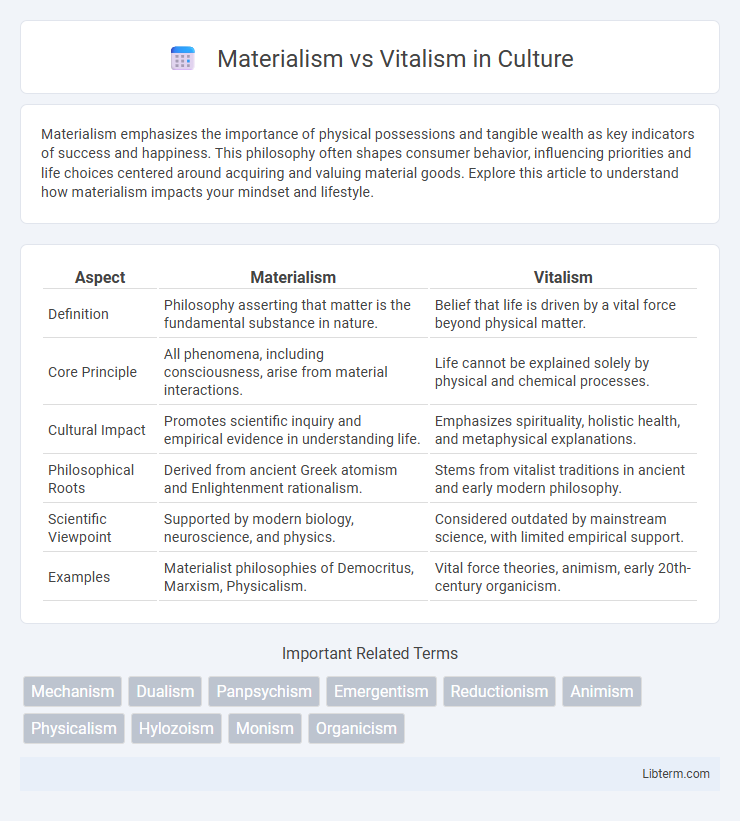Materialism emphasizes the importance of physical possessions and tangible wealth as key indicators of success and happiness. This philosophy often shapes consumer behavior, influencing priorities and life choices centered around acquiring and valuing material goods. Explore this article to understand how materialism impacts your mindset and lifestyle.
Table of Comparison
| Aspect | Materialism | Vitalism |
|---|---|---|
| Definition | Philosophy asserting that matter is the fundamental substance in nature. | Belief that life is driven by a vital force beyond physical matter. |
| Core Principle | All phenomena, including consciousness, arise from material interactions. | Life cannot be explained solely by physical and chemical processes. |
| Cultural Impact | Promotes scientific inquiry and empirical evidence in understanding life. | Emphasizes spirituality, holistic health, and metaphysical explanations. |
| Philosophical Roots | Derived from ancient Greek atomism and Enlightenment rationalism. | Stems from vitalist traditions in ancient and early modern philosophy. |
| Scientific Viewpoint | Supported by modern biology, neuroscience, and physics. | Considered outdated by mainstream science, with limited empirical support. |
| Examples | Materialist philosophies of Democritus, Marxism, Physicalism. | Vital force theories, animism, early 20th-century organicism. |
Introduction to Materialism and Vitalism
Materialism asserts that all phenomena, including consciousness and life processes, arise from physical matter and its interactions, emphasizing empirical evidence and scientific inquiry. In contrast, Vitalism posits that living organisms possess a unique "vital force" beyond physical and chemical laws, which vitalists argue is essential for explaining life's complexity and biological functions. The debate between Materialism and Vitalism centers on whether life can be fully understood through material processes alone or if an immaterial essence is necessary.
Historical Origins of Materialism
Materialism traces its historical origins to ancient Greek philosophers such as Democritus and Epicurus, who proposed that all matter consists of indivisible atoms moving in a void, rejecting supernatural explanations. During the Enlightenment, thinkers like Thomas Hobbes and John Locke further developed materialism by emphasizing empirical observation and the idea that mental phenomena arise from physical processes. This foundation contrasted with Vitalism, which held that life is driven by a special vital force beyond mere physical components.
Historical Roots of Vitalism
Vitalism, rooted in ancient Greek philosophy and prominently advanced by 17th and 18th-century thinkers like Georg Ernst Stahl, posits that living organisms possess a vital force distinguishing them from inanimate matter. This doctrine emerged as a counterpoint to materialism, which explains life processes solely through physical and chemical phenomena. The historical development of vitalism profoundly influenced early biological sciences by emphasizing life as governed by unique principles beyond mechanistic laws.
Core Principles of Materialism
Materialism asserts that all phenomena, including consciousness and life processes, are the result of material interactions governed by physical laws. It emphasizes that matter and energy constitute the fundamental components of reality, rejecting any non-physical or supernatural forces. This philosophy underpins scientific methods that study observable and measurable phenomena through empirical evidence.
Fundamental Tenets of Vitalism
Vitalism asserts that living organisms possess a unique vital force distinct from physical and chemical processes, emphasizing an inherent life energy that cannot be explained solely by material interactions. This doctrine contends that biological functions arise from this non-material vital principle, fundamentally differentiating living beings from inanimate matter. Opposed to materialism's reliance on physical laws, vitalism highlights irreducible life characteristics such as growth, reproduction, and metabolism driven by an intrinsic life force.
Major Debates: Materialism vs Vitalism
Materialism argues that all biological processes are the result of physical and chemical interactions within organisms, rejecting any non-material forces. Vitalism, in contrast, posits the existence of a vital force or life energy that cannot be explained by physical laws alone, emphasizing a distinct essence that animates living beings. The major debate centers on whether life can be fully understood through material mechanisms or if a unique, non-physical principle is essential for explaining biological phenomena.
Impact on Science and Medicine
Materialism, emphasizing physical matter as the foundation of reality, has driven scientific advancements through empirical research, fostering modern medicine's development via biology, chemistry, and neuroscience. Vitalism, positing a life force beyond physical entities, historically influenced early medical paradigms but declined as scientific methods disproved non-material explanations for biological processes. The materialist framework underpins contemporary medical practices, enabling innovations like pharmaceuticals and biotechnology, while vitalism's legacy remains in holistic and alternative medicine philosophies.
Criticisms and Controversies
Materialism faces criticism for oversimplifying complex biological phenomena by reducing life processes to mere physical and chemical interactions, often neglecting subjective experiences and consciousness. Vitalism is controversial for its reliance on an undefined "vital force," which lacks empirical support and contradicts established scientific principles. Both perspectives spark debate regarding the nature of life and consciousness, challenging the boundaries between science, philosophy, and metaphysics.
Contemporary Perspectives
Contemporary perspectives on materialism emphasize the brain's neurobiological processes as the foundation of consciousness and life functions, supported by advances in neuroscience and molecular biology. Vitalism, though largely marginalized in scientific discourse, persists in some alternative medicine and philosophical circles emphasizing an irreducible life force beyond physical mechanisms. Current research in systems biology and biosemiotics explores integrative models that challenge strict materialism without fully endorsing traditional vitalist concepts.
The Future of Materialism and Vitalism
The future of materialism in science emphasizes advancements in neurobiology and quantum physics to explain consciousness and life processes purely through physical phenomena. Vitalism, though largely marginalized, sees a resurgence in holistic and integrative medicine that highlights non-material life forces and energy fields in health and healing. Emerging interdisciplinary research may bridge gaps by exploring bioenergetics and informational theories, potentially transforming both paradigms.
Materialism Infographic

 libterm.com
libterm.com